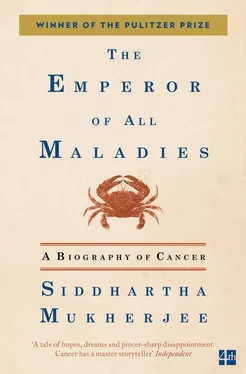1 ...6 7 8 10 11 12 ...17 Wills factor turned out to be folic acid, or folate, a vitamin-like substance found in fruits and vegetables (and amply in Marmite). When cells divide, they need to make copies of DNA—the chemical that carries all the genetic information in a cell. Folic acid is a crucial building block for DNA and is thus vital for cell division. Since blood cells are produced by arguably the most fearsome rate of cell division in the human body—more than 300 billion cells a day—the genesis of blood is particularly dependent on folic acid. In its absence (in men and women starved of vegetables, as in Bombay) the production of new blood cells in the bone marrow halts. Millions of half-matured cells spew out, piling up like half-finished goods bottlenecked in an assembly line. The bone marrow becomes a dysfunctional mill, a malnourished biological factory oddly reminiscent of the cloth factories of Bombay.

These links—between vitamins, bone marrow, and normal blood—kept Farber preoccupied in the early summer of 1946. In fact, his first clinical experiment, inspired by this very connection, turned into a horrific mistake. Lucy Wills had observed that folic acid, if administered to nutrient-deprived patients, could restore the normal genesis of blood. Farber wondered whether administering folic acid to children with leukemia might also restore normalcy to their blood. Following that tenuous trail, he obtained some synthetic folic acid, recruited a cohort of leukemic children, and started injecting folic acid into them.
In the months that passed, Farber found that folic acid, far from stopping the progression of leukemia, actually accelerated it. In one patient, the white cell count nearly doubled. In another, the leukemia cells exploded into the bloodstream and sent fingerlings of malignant cells to infiltrate the skin. Farber stopped the experiment in a hurry. He called this phenomenon acceleration 76, evoking some dangerous object in free fall careering toward its end.
Pediatricians at Children’s Hospital were furious about Farber’s trial. The folate analogues had not just accelerated the leukemia; they had likely hastened the death of the children. But Farber was intrigued. If folic acid accelerated the leukemia cells in children, what if he could cut off its supply with some other drug—an antifolate? Could a chemical that blocked the growth of white blood cells stop leukemia?
The observations of Minot and Wills began to fit into a foggy picture. If the bone marrow was a busy cellular factory to begin with, then a marrow occupied with leukemia was that factory in overdrive, a deranged manufacturing unit for cancer cells. Minot and Wills had turned the production lines of the bone marrow on by adding nutrients to the body. But could the malignant marrow be shut off by choking the supply of nutrients? Could the anemia of the mill workers in Bombay be re-created therapeutically in the medical units of Boston?
In his long walks from his laboratory 77under Children’s Hospital to his house on Amory Street in Brookline, Farber wondered relentlessly about such a drug. Dinner, in the dark-wood-paneled rooms of the house, was usually a sparse, perfunctory affair. His wife, Norma, a musician and writer, talked about the opera and poetry; Sidney, of autopsies, trials, and patients. As he walked back to the hospital at night, Norma’s piano tinkling practice scales in his wake, the prospect of an anticancer chemical haunted him. He imagined it palpably, visibly, with a fanatic’s enthusiasm. But he didn’t know what it was or what to call it. The word chemotherapy, in the sense we understand it today, had never been used for anticancer medicines.* The elaborate armamentarium of “antivitamins” that Farber had dreamed up so vividly in his fantasies did not exist.

Farber’s supply of folic acid for his disastrous first trial had come from the laboratory of an old friend, a chemist, Yellapragada Subbarao—or Yella, as most of his colleagues called him. Yella was a pioneer in many ways, a physician turned cellular physiologist, a chemist who had accidentally wandered into biology. His scientific meanderings had been presaged by more desperate and adventuresome physical meanderings. He had arrived in Boston in 1923 78, penniless and unprepared, having finished his medical training in India and secured a scholarship for a diploma at the School of Tropical Health at Harvard. The weather in Boston, Yella discovered, was far from tropical. Unable to find a medical job in the frigid, stormy winter (he had no license to practice medicine in the United States), he started as a night porter at the Brigham and Women’s Hospital, opening doors, changing sheets, and cleaning urinals.
The proximity to medicine paid off. Subbarao made friends and connections at the hospital and switched to a day job as a researcher in the Division of Biochemistry. His initial project involved purifying molecules out of living cells, dissecting them chemically to determine their compositions—in essence, performing a biochemical “autopsy” on cells. The approach required more persistence than imagination, but it produced remarkable dividends. Subbarao purified a molecule called ATP, the source of energy in all living beings (ATP carries chemical “energy” in the cell), and another molecule called creatine, the energy carrier in muscle cells. Any one of these achievements should have been enough to guarantee him a professorship at Harvard. But Subbarao was a foreigner, a reclusive, nocturnal, heavily accented vegetarian who lived in a one-room apartment downtown, befriended only by other nocturnal recluses such as Farber. In 1940, denied tenure and recognition, Yella huffed off to join Lederle Labs, a pharmaceutical laboratory in upstate New York, owned by the American Cyanamid Corporation, where he had been asked to run a group on chemical synthesis.
At Lederle, Yella Subbarao quickly reformulated his old strategy and focused on making synthetic versions of the natural chemicals that he had found within cells, hoping to use them as nutritional supplements. In the 1920s, another drug company 79, Eli Lilly, had made a fortune selling a concentrated form of vitamin B12, the missing nutrient in pernicious anemia. Subbarao decided to focus his attention on the other anemia, the neglected anemia of folate deficiency. But in 1946, after many failed attempts 80to extract the chemical from pigs’ livers, he switched tactics and started to synthesize folic acid from scratch, with the help of a team of scientists including Harriet Kiltie, a young chemist at Lederle.
The chemical reactions to make folic acid brought a serendipitous bonus. Since the reactions had several intermediate steps, Subbarao and Kiltie could create variants of folic acid through slight alterations in the recipe. These variants of folic acid—closely related molecular mimics—possessed counterintuitive properties. Enzymes and receptors in cells typically work by recognizing molecules using their chemical structure. But a “decoy” molecular structure—one that nearly mimics the natural molecule—can bind to the receptor or enzyme and block its action, like a false key jamming a lock. Some of Yella’s molecular mimics could thus behave like antagonists to folic acid.
These were precisely the antivitamins that Farber had been fantasizing about. Farber wrote to Kiltie and Subbarao asking them if he could use their folate antagonists on patients with leukemia. Subbarao consented. In the late summer of 1947, the first package of antifolate left Lederle’s labs in New York and arrived in Farber’s laboratory.
Читать дальше













